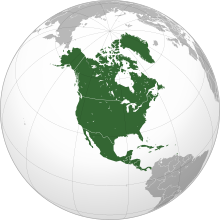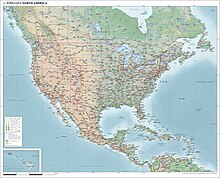 | |
| Area | 24.709 million km2 (9.54 million sq mi) (3rd) |
|---|---|
| Population | 592,296,233 (2021; 4th) |
| Population density | 25.7/km2 (66.4/sq mi) (2021)[a] |
| GDP (PPP) | $30.61 trillion (2022 est.; 2nd)[1] |
| GDP (nominal) | $29.01 trillion (2022 est.; 2nd)[2] |
| GDP per capita | $57,410 (2022 est.; 2nd)[3] |
| Religions | |
| Demonym | North American |
| Countries | 23 sovereign states |
| Dependencies | 23 non-sovereign territories |
| Languages | English, Spanish, French, Dutch, Danish, indigenous languages, and many others |
| Time zones | UTC−10:00 to UTC+00:00 |
| Largest cities | List of urban areas:[6] |
| UN M49 code | 003 – North America019 – Americas001 – World |

North America is a continent[b] in the Northern and Western Hemispheres.[c] North America is bordered to the north by the Arctic Ocean, to the east by the Atlantic Ocean, to the southeast by South America and the Caribbean Sea, and to the west and south by the Pacific Ocean. The region includes the Bahamas, Bermuda, Canada, the Caribbean, Central America, Clipperton Island, Greenland, Mexico, Saint Pierre and Miquelon, Turks and Caicos Islands, and the United States.
North America covers an area of about 24,709,000 square kilometers (9,540,000 square miles), representing approximately 16.5% of the Earth's land area and 4.8% of its total surface area. It is the third-largest continent by size after Asia and Africa, and the fourth-largest continent by population after Asia, Africa, and Europe. As of 2021[update], North America's population was estimated as over 592 million people in 23 independent states, or about 7.5% of the world's population. In human geography, the terms "North America" and "North American" can refer to Canada, the United States, Mexico, and Greenland or, alternatively, Canada, Greenland and the US (Mexico being classified as part of Latin America) or simply Canada and the US (Greenland being classified as either Arctic or European (due to its political status as a part of Denmark) and Mexico classified as Latin American).[7][8][9][10][11]
It is unknown with certainty how and when first human populations first reached North America. People were known to live in the Americas at least 20,000 years ago,[12] but various evidence points to possibly earlier dates.[13][14] The Paleo-Indian period in North America followed the Last Glacial Period, and lasted until about 10,000 years ago when the Archaic period began. The classic stage followed the Archaic period, and lasted from approximately the 6th to 13th centuries. Beginning in 1000 AD, the Norse were the first Europeans to begin exploring and ultimately colonizing areas of North America.
In 1492, the exploratory voyages of Christopher Columbus led to a transatlantic exchange, including migrations of European settlers during the Age of Discovery and the early modern period. Present-day cultural and ethnic patterns reflect interactions between European colonists, indigenous peoples, enslaved Africans, immigrants from Europe, Asia, and descendants of these respective groups.
Europe's colonization in North America led to most North Americans speaking European languages, such as English, Spanish, and French, and the cultures of the region commonly reflect Western traditions. However, relatively small parts of North America in Canada, the United States, Mexico, and Central America have indigenous populations that continue adhering to their respective pre-European colonial cultural and linguistic traditions.
Cite error: There are <ref group=lower-alpha> tags or {{efn}} templates on this page, but the references will not show without a {{reflist|group=lower-alpha}} template or {{notelist}} template (see the help page).
- ^ "GDP PPP, current prices". International Monetary Fund. 2021. Archived from the original on 22 January 2021. Retrieved 16 January 2022.
- ^ "GDP Nominal, current prices". International Monetary Fund. 2021. Archived from the original on 25 February 2017. Retrieved 16 January 2022.
- ^ "Nominal GDP per capita". International Monetary Fund. 2021. Archived from the original on 11 January 2020. Retrieved 16 January 2022.
- ^ "The Global Religious Landscape" (PDF). Pewforum.org. Archived from the original (PDF) on 25 January 2017. Retrieved 7 May 2020.
- ^ a b c d e f g "Religious Composition by Country, 2010–2050". pewforum.org. Archived from the original on 21 December 2019. Retrieved 17 February 2022.
- ^ "Demographia.com" (PDF). Archived (PDF) from the original on 14 August 2011. Retrieved 13 August 2015.
- ^ H. J. de Blij and Peter O. Muller. pGeography: Realms, Regions, and Concepts, Wiley, 12th ed., 2005, pp. 30–31, (ISBN 0-471-71786-X.)
- ^ Lewis, Martin W.; Wigen, Karen E. (1997). "Chapter One, The Architecture of Continents". The Myth of Continents. University of California Press. p. 168. ISBN 0-520-20742-4.
- ^ Burchfield, R. W., ed. 2004. "America." Fowler's Modern English Usage (ISBN 0-19-861021-1) New York: Oxford University Press, p. 48
- ^ McArthur, Tom. 1992."North American." The Oxford Companion to the English Language (ISBN 0-19-214183-X) New York: Oxford University Press, p. 707.
- ^ "Common Errors in English Usage". Paul Brians, Washington State University. 16 May 2016. Archived from the original on 24 April 2022. Retrieved 4 April 2022.
- ^ Pigati, Jeffrey S.; Springer, Kathleen B.; Honke, Jeffrey S.; Wahl, David; Champagne, Marie R.; Zimmerman, Susan R. H.; Gray, Harrison J.; Santucci, Vincent L.; Odess, Daniel; Bustos, David; Bennett, Matthew R. (6 October 2023). "Independent age estimates resolve the controversy of ancient human footprints at White Sands". Science. 382 (6666): 73–75. Bibcode:2023Sci...382...73P. doi:10.1126/science.adh5007. ISSN 0036-8075. PMID 37797035. S2CID 263672291. Archived from the original on 5 October 2023. Retrieved 6 December 2023.
- ^ Goodyear, Albert C.; Sain, Douglas A. (22 May 2018). "The Pre-Clovis Occupation of the Topper Site, Allendale County, South Carolina". Early Human Life on the Southeastern Coastal Plain. University Press of Florida. pp. 8–31. doi:10.5744/florida/9781683400349.003.0002. ISBN 978-1-68340-034-9. Archived from the original on 7 December 2023. Retrieved 5 December 2023.
- ^ Ardelean, Ciprian F.; Becerra-Valdivia, Lorena; Pedersen, Mikkel Winther; Schwenninger, Jean-Luc; Oviatt, Charles G.; Macías-Quintero, Juan I.; Arroyo-Cabrales, Joaquin; Sikora, Martin; Ocampo-Díaz, Yam Zul E.; Rubio-Cisneros, Igor I.; Watling, Jennifer G.; de Medeiros, Vanda B.; De Oliveira, Paulo E.; Barba-Pingarón, Luis; Ortiz-Butrón, Agustín (22 July 2020). "Evidence of human occupation in Mexico around the Last Glacial Maximum". Nature. 584 (7819): 87–92. Bibcode:2020Natur.584...87A. doi:10.1038/s41586-020-2509-0. ISSN 1476-4687. PMID 32699412. S2CID 256819465. Archived from the original on 21 April 2021. Retrieved 6 December 2023.